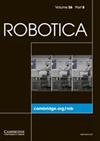基于高效储能结构的仿生四足跳跃机器人研究
IF 2.7
4区 计算机科学
Q3 ROBOTICS
引用次数: 0
摘要
四足机器人克服障碍的能力是限制其实际应用的关键因素。本文介绍了一种设计理念和控制算法,旨在通过利用弹性储能元件来增强四足机器人在跳跃过程中的爆发力。四足机器人的后腿被设计为能量存储单元。拉伸弹簧被用作储能元件,并以平行结构安装在后腿上。能量在机器人躯干压缩过程中储存,在跳跃阶段释放。最佳脚力是通过单一刚体模型计算得出的。通过开发后腿的动态模型,建立了施加在脚上的力与由此产生的关节扭矩之间的映射关系。使用 Webots 物理引擎进行了模拟实验,以比较跳跃过程中不同弹簧刚度对关节扭矩的影响。这项研究确定了特定条件下的最佳弹簧刚度。后腿的扭矩节省率达到 19%,能量节省率达到 13%,验证了集成弹性储能组件的有效性和可行性。本文章由计算机程序翻译,如有差异,请以英文原文为准。
Research on the biomimetic quadruped jumping robot based on an efficient energy storage structure
The ability of quadruped robots to overcome obstacles is a critical factor that limits their practical application. Here, a design concept and a control algorithm are presented that aim at enhancing the explosive force of quadruped robots during jumping by utilizing elastic energy storage components. The hind legs of the quadruped robot are designed as energy storage units. Tension springs are utilized as components for storing energy and are installed in a parallel structure on the hind leg. Energy is stored during the compression process of the robot’s torso and released during the jumping phase. The optimal foot force is calculated using a single rigid body model. The mapping relationship between the force applied to the foot and the resulting joint torque is established by developing a dynamic model of the hind legs. Simulation experiments were conducted using the Webots physics engine to compare the impact of varying spring stiffness on joint torque during the jumping process. This study determined the optimal spring stiffness under specific conditions. The hind legs’ torque saving ratio reaches 19%, and the energy-saving ratio reaches 13%, which validates the effectiveness and feasibility of integrating elastic energy storage components.
求助全文
通过发布文献求助,成功后即可免费获取论文全文。
去求助
来源期刊

Robotica
工程技术-机器人学
CiteScore
4.50
自引率
22.20%
发文量
181
审稿时长
9.9 months
期刊介绍:
Robotica is a forum for the multidisciplinary subject of robotics and encourages developments, applications and research in this important field of automation and robotics with regard to industry, health, education and economic and social aspects of relevance. Coverage includes activities in hostile environments, applications in the service and manufacturing industries, biological robotics, dynamics and kinematics involved in robot design and uses, on-line robots, robot task planning, rehabilitation robotics, sensory perception, software in the widest sense, particularly in respect of programming languages and links with CAD/CAM systems, telerobotics and various other areas. In addition, interest is focused on various Artificial Intelligence topics of theoretical and practical interest.
 求助内容:
求助内容: 应助结果提醒方式:
应助结果提醒方式:


